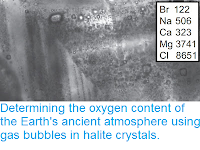Around two-and-a-half billion years ago, bands of iron oxides began to be deposited in ocean basins around the world. These Banded Ironstone Formations are considered to be evidence of oxygen-producing photosynthetic organisms colonising the oceans, leading to oxygen reacting with iron dissolved in the seawater to produce iron-oxide precipitates, which fell to the ocean floor. Once all of the dissolved iron had been reacted, oxygen began to build up in the atmosphere, resulting in the Great Oxidation Event of about 2.45 billion years ago, marking the boundary between the Archean and Proterozoic Eons. However, in 2014 a team of scientists led by Birgir Rasmussen of Curtin University proposed an alternative explanation for the formation of Banded Ironstone Formations, arguing that the presence of the mineral greenalite in the Transvaal Supergroup of South Africa the and Hamersley Group of Australia implies that the iron was not oxidised when it was deposited, and that the ironstone was instead formed post-depositionally by the peculation of oxygen-rich waters through iron rich deposits.
In a paper published in the journal Nature Geoscience on 27 May 2019, Leslie Robbins of the Department of Earth & Atmospheric Sciences at the University of Alberta and the Department of Geology and Geophysics at Yale University, Sean Funk, also of the Department of Earth & Atmospheric Sciences at the University of Alberta, Shannon Flynn of the School of Natural and Environmental Sciences at Newcastle University, Tyler Warchola, also of the Department of Earth & Atmospheric Sciences at the University of Alberta, Zhiquan Li, again of the Department of Earth & Atmospheric Sciences at the University of Alberta, and of the State Key Laboratory of Geological Processes and Mineral Resources at the China University of Geosciences, and the Key Laboratory of Mineral Resources at the Institute of Geology and Geophysics of the Chinese Academy of Sciences, Stefan Lalonde of the Laboratoire Géosciences Océan of the European Institute for Marine Studies, Benjamin Rostron, again of the Department of Earth & Atmospheric Sciences at the University of Alberta, Albertus Smith, Nicolas Beukes, and Michiel de Kock of the Paleoproterozoic Mineralization Research Group and National Research Foundation Centre of Excellence for Integrated Mineral and Energy Resource Analysis, at the University of Johannesburg, and Larry Heaman, Daniel Alessi, and Kurt Konhauser, again of the Department of Earth & Atmospheric Sciences at the University of Alberta, present the results of a computer simulation of the formation of Banded Ironstone Formations in the Hamersley Group of Australia, which seeks to assess whether such a model is plausible.
The Hamersley Group has an aerial exposure of over 100 000 square kilometres, is over 2.5 km thick, and comprises the Marra Mamba, Brockman, Weeli Wolli and Boolgeeda iron formations, together laid down between about 2.6 and 2.45 billion years ago. Robbins et al. constructed a model in which the target percentage of iron oxidised, permeability of the rock, hydraulic gradient and dissolved oxygen concentration could all be varied, producing a total of 3 802 356 permutations of the model.
Conceptual model for the postdepositional oxidation of greenalite by oxidative groundwater. (a)–(c) Deposition of a greenalite precursor phase (a) followed by postdepositional oxidation pathways that include early diagenetic fluids (b) or infiltration of a meteoric oxidizing fluid and flow parallel to iron-rich layers (c). (d) Banding preserved in the Joffre Member of the Brockman Iron Formation, Western Australia. Any postdepositional oxidation must be capable of explaining the preservation of the distinct banding characteristic of Banded Ironstone Formations. Robbins et al. (2019).
Robbins found that of the 3 802 356 permutations of the model, only 8.87% were capable of oxidising all of the iron in the Hamersley Group in the 2.45 billion years available since the deposits were laid down, and only ~1.06% were capable of doing this in the 250 million years available before the rocks of the Turee Creek Group covered the Hamersley Group to such an extent that compaction of the Hamersley deposits would have made the flow of oxygenated groundwater more-or-less impossible. Furthermore, all of these 'succesful' permutations of the model require high levels of permeability within the sediments (unlikely within a 2.5 km thick deposit in a deep marine environment) combined with a high oxygen content in the permeating water (again unlikely in deep marine environments today, and much less so in the Palaeonproterozoic, when only the upper part of the water column is thought to have been weakly oxygenated.
Robbins et al. also see a number of other problems with the post-depositional oxygenation model. These include the presence of millimetre scale bands in the deposits, which would almost certainly have been disrupted by peculating waters and oxygenation (iron oxides take up more space than unoxygenated iron compounds, and conversion of one to the other tends to result in the loss of fine structures, most notably in the flaking associated with rusting iron). Robbins et al. also note that Rare Earth Elements are present in the Hamersley Banded Ironstones in roughly the proportions expected in sediments deposited in marine environments, a ratio that would normally be disrupted by highly oxygenated waters flowing through the rock.
Robbins et al. conclude that the post-depositional oxygenation of the iron in the Hamersley Group is highly implausible, if not actually impossible. They further note that any such event would have to have not only affected the rocks of ironstones of the Hamersley Group, but also those of the Transvaal Supergroup, with an aerial extent of 110 000 square kilometres, and a thickness of 950 m, which is thought to have been laid down in a connected, adjacent basin to the Hamersley Group, as well as those of the Kursk Supergroup in Russia, the Krivoy Rog Supergroup in Ukraine, the Cauê Formation in Brazil, the Benchmark Iron Formation in the US and the Ruker Series in Antarctica.
See also...
Follow Sciency Thoughts on Facebook.







